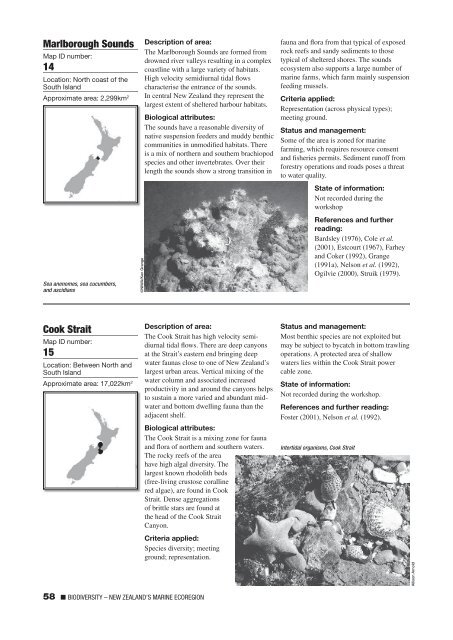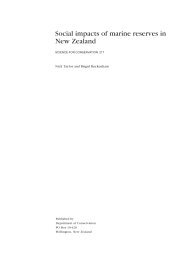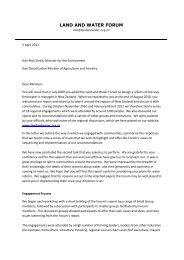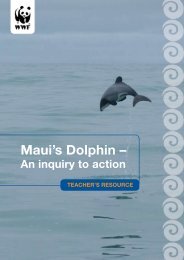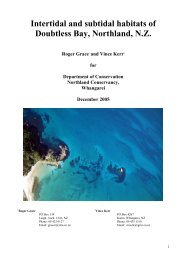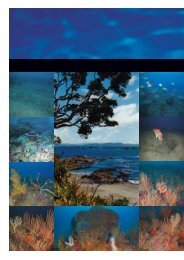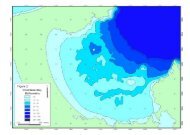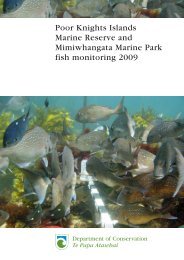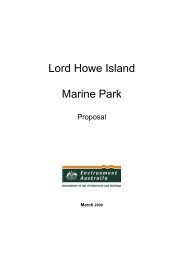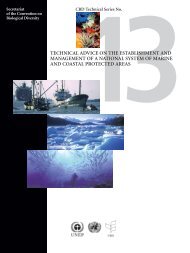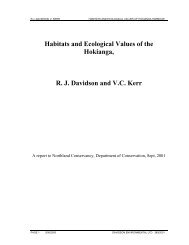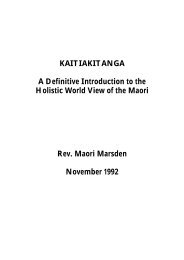WWF Shining a spotlight on the biodiversity of ... - MarineNZ.org.nz
WWF Shining a spotlight on the biodiversity of ... - MarineNZ.org.nz
WWF Shining a spotlight on the biodiversity of ... - MarineNZ.org.nz
You also want an ePaper? Increase the reach of your titles
YUMPU automatically turns print PDFs into web optimized ePapers that Google loves.
Marlborough Sounds<br />
Map ID number:<br />
14<br />
Locati<strong>on</strong>: North coast <strong>of</strong> <strong>the</strong><br />
South Island<br />
Approximate area: 2,299km 2<br />
Sea anenomes, sea cucumbers,<br />
and ascidians<br />
©NIWA/Ken Grange<br />
Descripti<strong>on</strong> <strong>of</strong> area:<br />
The Marlborough Sounds are formed from<br />
drowned river valleys resulting in a complex<br />
coastline with a large variety <strong>of</strong> habitats.<br />
High velocity semidiurnal tidal flows<br />
characterise <strong>the</strong> entrance <strong>of</strong> <strong>the</strong> sounds.<br />
In central New Zealand <strong>the</strong>y represent <strong>the</strong><br />
largest extent <strong>of</strong> sheltered harbour habitats.<br />
Biological attributes:<br />
The sounds have a reas<strong>on</strong>able diversity <strong>of</strong><br />
native suspensi<strong>on</strong> feeders and muddy benthic<br />
communities in unmodified habitats. There<br />
is a mix <strong>of</strong> nor<strong>the</strong>rn and sou<strong>the</strong>rn brachiopod<br />
species and o<strong>the</strong>r invertebrates. Over <strong>the</strong>ir<br />
length <strong>the</strong> sounds show a str<strong>on</strong>g transiti<strong>on</strong> in<br />
fauna and flora from that typical <strong>of</strong> exposed<br />
rock reefs and sandy sediments to those<br />
typical <strong>of</strong> sheltered shores. The sounds<br />
ecosystem also supports a large number <strong>of</strong><br />
marine farms, which farm mainly suspensi<strong>on</strong><br />
feeding mussels.<br />
Criteria applied:<br />
Representati<strong>on</strong> (across physical types);<br />
meeting ground.<br />
Status and management:<br />
Some <strong>of</strong> <strong>the</strong> area is z<strong>on</strong>ed for marine<br />
farming, which requires resource c<strong>on</strong>sent<br />
and fisheries permits. Sediment run<strong>of</strong>f from<br />
forestry operati<strong>on</strong>s and roads poses a threat<br />
to water quality.<br />
State <strong>of</strong> informati<strong>on</strong>:<br />
Not recorded during <strong>the</strong><br />
workshop<br />
References and fur<strong>the</strong>r<br />
reading:<br />
Bardsley (1976), Cole et al.<br />
(2001), Estcourt (1967), Farhey<br />
and Coker (1992), Grange<br />
(1991a), Nels<strong>on</strong> et al. (1992),<br />
Ogilvie (2000), Struik (1979).<br />
Cook Strait<br />
Map ID number:<br />
15<br />
Locati<strong>on</strong>: Between North and<br />
South Island<br />
Approximate area: 17,022km 2<br />
Descripti<strong>on</strong> <strong>of</strong> area:<br />
The Cook Strait has high velocity semidiurnal<br />
tidal flows. There are deep cany<strong>on</strong>s<br />
at <strong>the</strong> Strait’s eastern end bringing deep<br />
water faunas close to <strong>on</strong>e <strong>of</strong> New Zealand’s<br />
largest urban areas. Vertical mixing <strong>of</strong> <strong>the</strong><br />
water column and associated increased<br />
productivity in and around <strong>the</strong> cany<strong>on</strong>s helps<br />
to sustain a more varied and abundant midwater<br />
and bottom dwelling fauna than <strong>the</strong><br />
adjacent shelf.<br />
Biological attributes:<br />
The Cook Strait is a mixing z<strong>on</strong>e for fauna<br />
and flora <strong>of</strong> nor<strong>the</strong>rn and sou<strong>the</strong>rn waters.<br />
The rocky reefs <strong>of</strong> <strong>the</strong> area<br />
have high algal diversity. The<br />
largest known rhodolith beds<br />
(free-living crustose coralline<br />
red algae), are found in Cook<br />
Strait. Dense aggregati<strong>on</strong>s<br />
<strong>of</strong> brittle stars are found at<br />
<strong>the</strong> head <strong>of</strong> <strong>the</strong> Cook Strait<br />
Cany<strong>on</strong>.<br />
Criteria applied:<br />
Species diversity; meeting<br />
ground; representati<strong>on</strong>.<br />
Status and management:<br />
Most benthic species are not exploited but<br />
may be subject to bycatch in bottom trawling<br />
operati<strong>on</strong>s. A protected area <strong>of</strong> shallow<br />
waters lies within <strong>the</strong> Cook Strait power<br />
cable z<strong>on</strong>e.<br />
State <strong>of</strong> informati<strong>on</strong>:<br />
Not recorded during <strong>the</strong> workshop.<br />
References and fur<strong>the</strong>r reading:<br />
Foster (2001), Nels<strong>on</strong> et al. (1992).<br />
Intertidal <strong>org</strong>anisms, Cook Strait<br />
Allis<strong>on</strong> Arnold<br />
58 ■ BIODIVERSITY – NEW ZEALAND’S MARINE ECOREGION


